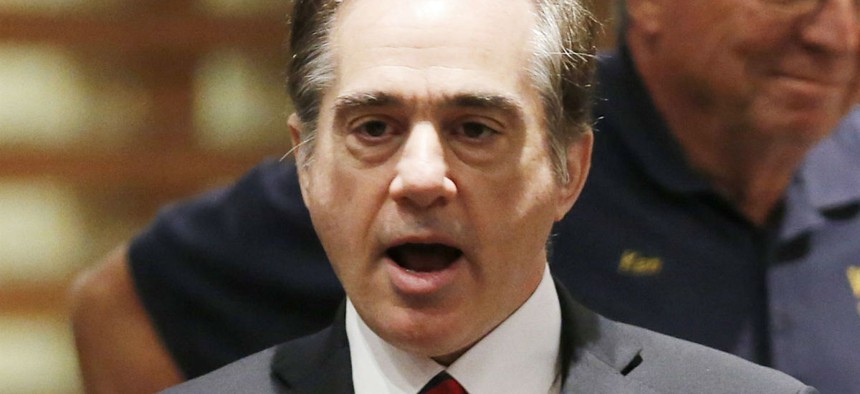As VA Tackles Veteran Suicide, Its Image Problem Continues to Hurt Doc Recruitment
The department's most comprehensive analysis of veteran suicide ever estimates that 20 veterans a day kill themselves.
Veterans Affairs has hired nearly 800 psychologists and psychiatrists since 2014, but it still struggles to attract all kinds of doctors because of the department’s image problems, said the VA undersecretary of health.
“Our applications for clinical positions across the board are down 78 percent,” since the patient wait times scandal erupted two years ago, said Dr. David Shulkin, during a Thursday call with reporters about the department’s latest suicide data on veterans. “I don’t have a specific number for what percent are mental health professionals, but yes, it has been a challenge for us.”
Shulkin unveiled some of the data from the VA’s most comprehensive look at veteran suicide, which will be fully released at the end of July. The study, which examined more than 55 million veteran records from 1979 to 2014 from all 50 states, showed that on average 20 veterans a day kill themselves. A much less exhaustive 2010 study analyzed roughly 3 million veteran records from just 20 states, and concluded that on average 22 veterans a day took their own lives. That statistic was widely reported, but found to be misleading given the size of the study. Shulkin said the VA is going to input the 2010 data using all 50 states to see whether the estimate of 22 vets was accurate.
“That was an incomplete estimate,” said Shulkin. “Today, we can say accurately that it’s 20.” Sixty-five percent of vets who died from suicide were age 50 and older in 2014, according to the data. But the group with the highest suicide risk factor was in the 18-to-29 age group – post-9/11 vets. “So although the largest number of veterans taking their life are still older, the highest incidence of suicide is in the younger age group,” Shulkin said. Overall, 7,403 veterans took their own lives in 2014.
While 20 is lower than 22, the actual rate of suicide is increasing because the overall veteran population is decreasing, Shulkin said. “I will not say that anybody should feel good about 20 suicides a day, or that we are declaring that this is progress,” the health undersecretary said. “This is why we are being extra aggressive with these new efforts and not satisfied with where we are.”
Hiring and training more mental health professionals is a key component of the VA’s multi-pronged initiative to prevent suicide among vets. The department trains 8,000 mental health students each year – the largest such training program in the country, according to Shulkin. Many of the trainees stay with the VA, Shulkin said, but the department is using the web, job fairs and professional associations to attract more mental health professionals. The VA is also using recruitment incentives, including helping hires with student debt, and trying to obtain more flexibility to offer higher pay that is better aligned with the private sector.
“We are trying to go out there, and tell our story about why this is a meaningful place to spend your career, but clearly this is a challenge for us,” Shulkin said.
The department also is hiring more than 60 new suicide intervention responders and counselors for its crisis line, as well as pledging to provide same-day urgent mental health evaluations at every VA medical center by the end of 2016. A new data analytics tool that helps doctors predict which vets are most at risk for suicide will be available to clinicians this fall “so they can make more immediate and informed decisions,” Shulkin said. Other efforts under way include expanding telemental health services, particularly in rural areas, working with the Defense Department to help service members better transition to veteran status so they don’t fall through the cracks, and boosting mental health services for female vets. Since 2001, the age-adjusted rate of suicide among female vets has increased 85.2 percent. VA’s data showed that the suicide rate increase among female vets was much lower for those who used VA health care services during the same time period compared to female vets receiving non-VA care: a 4.6 percent increase compared to a 98 percent increase.
There are roughly 20 million vets now, fewer than in 2001, and VA provides benefits and services to between 15 percent and 26 percent of that group each year. The numbers and demographics of the population are fluid though, given the aging veteran population, increase in female service members and the growing racial diversity of the armed services. That means their needs and expectations are changing as well. Despite its well-documented problems and mismanagement, the VA has increasingly become a health care safety net for many vets, according to the June 2016 issue of Health Affairs Journal.
In August 2014, President Obama announced 19 executive orders designed to boost mental health care for veterans, and help troops make the transition from military health care to VA or civilian care through better coordination, the inTransition program and the uninterrupted delivery of mental health medications. But some advocates at the time did not think the efforts went far enough and were more cosmetic than substantive.
Nevertheless, the administration and Congress have been more focused in recent years on suicide prevention among vets. In 2015, Congress passed the Clay Hunt Suicide Prevention for American Veterans Act, a law that requires independent reviews of the VA’s mental health care services and programs to prevent suicide. It also establishes a pilot program to repay the student loans of psychiatrists who commit to working for the Veterans Health Administration, and another to assist service members transitioning from active duty.
The law is named after Clay Hunt, a Marine Corps combat vet deployed to Iraq and Afghanistan, who killed himself in 2011.




